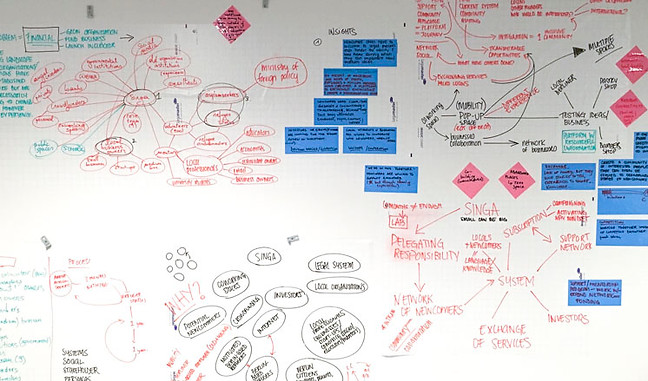
As an Emerging Leaders Fellow at the UnSchool of Disruptive Design, I collaborated with a team of four international fellows to develop innovative and inclusive ideas for SINGA Deutschland in Berlin during a 24-hour design challenge. SINGA is part of an international network of organizations. In Germany, its mission is to connect newcomers (refugees, asylum seekers, and other immigrants) with locals through a variety of events and activities. By applying systems thinking and service design methods, we created IdeaParty!, an event that serves as a platform to network and co-create new ideas and businesses. Upon winning the challenge, this project was quickly implemented into SINGA’s program.
Collaborators: Ameenah Sawwan, Lien De Ruyck and Janine Morton | Time Frame: October 2016 | 24-hour Design Challenge Winner
Idea party!
How might an intervention, free of government or grant approvals, alleviate issues of access, so that SINGA may better serve its community members?
Bureaucracy and administrative systems often inhibit access to key services that are necessary for people to settle, live and grow in Europe. Given Germany's difficult asylum process and Newcomers' lack of access to credit, We sought to explore potential interventions that might relieve issues of access to opportunities and information for newcomers in berlin, Germany.

Exploring the context
Some challenges newcomers are faced by upon arriving in Germany are lack of information and resources (i.e. legal paperwork and setting up businesses), as well as a sense of separation from locals. We also learned that Berlin houses a large start-up community. Given the project's time frame, our three priorities were to meet newcomers and gather a sense of their experiences, speak with individuals in the start-up community, and identify how other countries and organizations are providing newcomers legal information and fostering collaboration. One of our team members was a Syrian refugee in Berlin at the time. Through her, we had direct access to other refugees, as well as asylum seekers and other immigrants. After meeting several newcomers and local creatives, we quickly learned that there is a mutual desire to collaborate. Collaboration is highly promoted in Berlin’s start-up community, and they are often seeking out new talent.


um Abdul & imad
“I have the will, but it is not enough."
IHab
"With us, not for us.”
insights
Being part of the process
Services established for a specific user should be designed with and for that user.
building bridges & establishing Networks
An in-between person is key during the development of a support system.
transparency & consultancy
Having the right support is important throughout the process of establishing in a new place and for the creation of new ideas.
How might we create bridges that lead to a seamless and collaborative nature between local start-ups and newcomers?
discovering opportunities
As we began to explore design opportunities, we relied heavily on role-playing. Role-playing helped us further identify the needs and capabilities of each stakeholder, which then led us to formulate more concrete ideas. Some factors that proved most important during our design process were understanding the capabilities and limitations of each stakeholder and the viability of design solutions. We created a map in which we identified three main stakeholders: newcomers, creatives, and the in-between person who would serve as a connection factor.

Creatives are students, recent grads, entrepreneurs, and artists, among many others. Creatives are individuals who are interested in connecting with a broader network or are looking to raise their profiles. They are also motivated by the prospect of exploring new ideas and exploring new knowledge.
Creatives
In-Betweens
In-betweens might be refugees or asylum seekers that have been living in Berlin for some time, or they might be established businesses or even locals that know the newcomers’ language. They might not have the answers to all the newcomer’s questions, but they know and understand how the legal system works. Their motivations include, but are not limited to, altruism and a desire to pay forward.
Newcomers are refugees, asylum seekers, and immigrants. More often than not, they are faced with language and cultural barriers. Some of their motivations include a desire to connect with locals and other newcomers and the need for support.
Newcomers
Throughout our ideation process, we kept coming back to the fact that by connecting entrepreneurs (both newcomers and locals), they can overcome language and cultural barriers and they can understand Berlin from another perspective. We developed what we called IdeaParty!. IdeaParty! is an event that uses social exchange as a primary tool to bring together newcomers, in-betweens, and creatives. It is an opportunity to share ideas, collaborate, get feedback, and promote positive a attitude. By means of networking, IdeaParty! serves as a platform through which newcomers have direct access to information, talent, and other resources that are essential to establishing a new business.

Concept overview
When reaching out to the community, trust is essential. In-betweens would serve as ambassadors, mainly for the newcomer community. Given that Facebook groups are heavily used within the newcomer community, they would serve as a main communication method with newcomers. The event would also rely on an open call to creatives through universities and co-working spaces, among others.
IdeaParty! is meant to be a recurring event. however, upon assisting IdeaParty!, each project will develop according to its individual needs. This being said, IdeaParty! has the potential to create a space for social contracts and agreements or even a pay forward method.